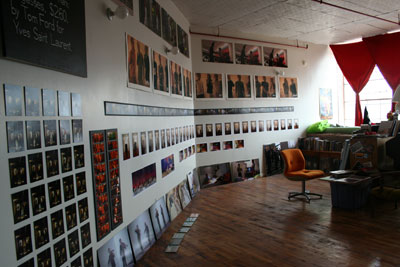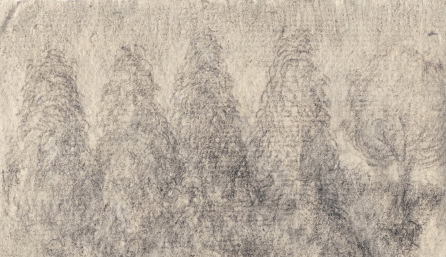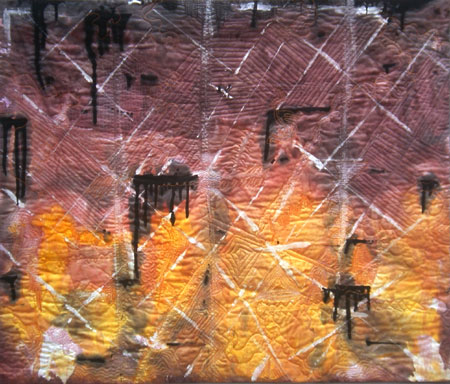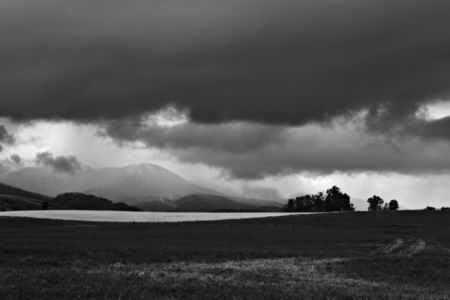Posted by Steve Durbin on June 8th, 2007
This past weekend, I opened the doors of my live/work studio as part of the Bushwick Open Studios and Arts Festival in Brooklyn, New York. It was my first open studio, so I had the opportunity to plaster the walls with my art that had been collecting dust under my bed. The art I hung was the kind of artwork that I considered to be my contribution to the history of art—the work that I would want to be a part of the ‘art world’ and more specifically, artwork that I would submit to galleries for open calls. Here is an example of my open studio space:

more… »
Posted by Karl Zipser on June 6th, 2007

Painting
From Life vs.
From Photos

Traveling makes one aware of constraints of time and space. If I am in Paris today, but I won’t be tomorrow, I need to make the most of the present opportunities.
Painting in the same studio from day to day gives the impression of being in the same place. Working with the same types of materials over time gives a sense of continuity. I’m realizing how much this is an illusion, in the dimension of the art itself.
I can look at older work and enjoy it, but I can’t go back to the “place” I was when I made it — as much as I would like to sometimes. Depending on the type of work and the progress I am making, “old” can mean a year or two weeks. What I am doing on a given day defines a “place” that I found a path to from yesterday. I won’t be able to return most likely. I need to make the most of the place where I am at the moment, then move on.
On this journey an itinerary is not available. If I try to look back or too far ahead, I risk losing my way.
Posted by Doug Plummer on June 5th, 2007

Two recent blog entries, one by Paul Butzi (I’ve been riffing off him a lot lately) on photographing “Close To Home,” and Birgit’s “Dune Quest” have got me thinking about the notational aspects of artmaking. Namely, the daily investigation of ideas and how that relates to projects of “greater” importance.
more… »
Posted by June Underwood on May 25th, 2007

Farmland, 36 x 43, painted cotton
I have lived many places, and in each, I have always had a strong sense of the place itself — the trees and plants, the nature of the cultivated earth, the nature of the uncultivated earth, the sky, winds, air, light — I can describe all these with a fair amount of detail.
But I seldom had to try to recap in art what I know about a place where I no longer live. However, now I am doing so.
“Paint what’s around you,” seems to be a sound admonition, but what is around me is the opposite, environmentally speaking, of what I am painting. more… »
Posted by Doug Plummer on May 21st, 2007
Paul Butzi has a provocative series of posts on Musings, in his typically thoughtful style, about the necessity to seal himself off from influences, particularly the media. I have great respect for his thinking, but I offered a different take in a long comment on his recent post. I’m appropriating myself and posting it here.
Paul,
As I understand you position, you’re saying that in order to protect the integrity of your experience, you have to deliberately isolate yourself from stimulus that might become a mediating influence, because it deters and inhibits the sense of being in the moment.
My retort is twofold, one about artistic influences, and the other about mass media (we won’t talk about the intersection of these two sets, which is an interesting arena that a lot of artists use to make some important work, and always have). I contend that isolating yourself from other artistic influences is a big disservice to one’s own process.
My feeling is, that the more I know about what has gone on before me, the more roots there are to feed my own work. I visit museums and galleries whenever I travel, and I make it a priority. I have arenas of art work that I like to look at and that I respect, and large swaths that I pretty much ignore. But I don’t prohibit it from feeding my process. Even work I argue with grows me.
Allowing Italian Renaissance art into one’s process is one thing. Mass media is harder to defend. But much of the art I adore was the mass media of its era. I am writing this while I am watching my guilty pleasure, “Dancing With The Stars.” I’m working on a dance project. I’m interested in the popular culture take on dance, and I love that this show highlights and rewards a kind of (well, vulgur) virtuosity. Because I make a living from my artistic process, I pay attention to the trends and patterns in how the media mediates our culture back to ourselves.
I don’t like a lot of what I see, of course. That’s beside the point. Anyone with a lick of self respect is going to be majorly frustrated with the culture we live in. The way I inoculate myself from the media onslaught is to pay attention to it. I deconstruct how it works, what it’s trying to say, and the meta messages within it. But sometimes the production values speak to some of the best artistic output of our era. Or at least, it informs me about what is the visual vocabulary of our time.
Posted by Steve Durbin on May 15th, 2007

It’s that hair-pulling but hopefully insightful time when I have to write an Artist’s Statement. I’ve done this before for particular projects or shows, but this is the first time I’ve tried to write a general statement about myself as an artist. The purpose is to provide information to interested visitors at the gallery I’ve recently joined. So my audience is the general public, or at least that part which would visit an art gallery. I feel that’s quite a different audience from other artists (like you all), in turn different from a narrower group, such as photographers working in black and white.
I take the statement very seriously as a way not only to communicate, but for me to consider what is really important, perhaps defining, about my artistic endeavor. The tone of it is critical. I don’t want to be too “artsy” or intellectual, nor do I want to condescend. I want it to be straightforward, but at the same time I want it to entice and suggest rather than answer all questions. It needs to have a personal voice, to sound like something I would say, and ideally not like something anyone else would say. This is what I’ve got so far:
more… »
Posted by Rex Crockett on May 11th, 2007
Steve Durbin brought up the question of how do artists cook a while back, but I was not able to comment as much as I would have liked then; furthermore, I came across, again, some famous old thoughts on the subject, and I thought I’d share them with you.
First though, I’ve just been promoted from Sous Chef to Executive Chef at the resort where I work. Unfortunately, I’m always working now at least twelve hours a day. It’s my own fault, the long hours, for I fired all the lazy hacks on my first day on the job. I will have only focused professionalism in my crew even if it means pulling shifts for a time.
Involved as I am with the menu planning and presentation of our banquets for the coming season, the relationship between a practical, applied art, like cooking, and a more ethereal art, like painting, has been much on my mind. It’s been only on my mind and not expressed in art work because of my long hours.
I would not regard the following observations to be completely definitive statements for all art, merely facets of a diamond, and one possible diamond at that. I offer no images in this post, only ideas. But they are some good ones, I think.
more… »





